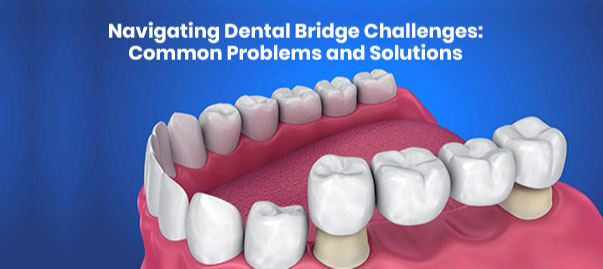
Navigating Dental Bridge Challenges: Common Problems and Solutions
Dental bridges are a flawless and highly efficient solution for the replacement of missing teeth. They will restore functionality to your smile, but they will also make your smile more beautiful. Yet, just like with any dental restoration, sometimes everything doesn’t go as smoothly as planned. Here we’ll discuss common problems with dental bridges and concrete, actionable solutions for you in navigating these problems.
Discomfort and Sensitivity
The most common problem concerning the dental bridge is pain and sensitivity, which may result from ill-fitting of the bridge or improper alignment in biting.
Solution: If you feel pain or discomfort with your dental bridge, schedule an appointment with your dentist for an assessment. He can examine whether it fits and make the necessary adjustments or prescribe a different therapy. He could also advise you to use a desensitizing toothpaste or a mouthwash to help you manage the sensitivity while going about your activities.
Dental Bridge Fracture
A dental bridge is constructed with longevity and durability in mind, though fractures or cracks may occur due to accidents, trauma, or overwork from chewing hard foods.
Solution: If your dental bridge breaks, contact a dentist as soon as possible. The dentist will assess the damage and recommend the appropriate course of treatment. Sometimes, the bridge might be salvageable. In other instances, replacement may be necessary since the damage may be severe.
Poor Oral Hygiene
Proper oral hygiene is the secret to the lifespan of your dental bridge. Failure to provide proper dental care leads to plaque and bacterial accumulation, causing gum disease and decay along the bridge. This can lower the strength of the supporting teeth and threaten the bridge structure.
Solution: Preventive problems of poor oral health are attained by practicing a good routine of oral care. Brush your teeth at least twice a day, brush your floss once a day, and sometimes use an antibacterial mouthwash to keep your teeth healthy.
Bridge Debonding
At times, the bridge may debond when it has loosen and is painful to bite foods. Debonding of the bridge occurs due to weakening of cement or adhesive, improper placing of the bridge, and poor oral care.
If the bridge is debonded, see your dentist immediately. She will inspect the bridge to determine what should be done. In some cases, she will re-cement it. More likely, however, she will recommend that a new bridge be made.
Do not attempt to correct it yourself; this may only make things worse.
Esthetic Issues
Now and then, some dental problems related to the esthetic aspect of a dental bridge can be observed such as color mismatching and visible metallic components that may reduce the patient’s confidence in both smiling and speaking.
Solution: If you don’t like the appearance of your dental bridge, you are free to point this to your dentist. You can either have it replaced with a more aesthetic material or dental veneers to give your smile a good aesthetic look. Your dentist will work you out to come up with a solution that suits your needs and improves your smile.
With good oral hygiene and quick intervention when problems occur, you’ll enjoy a long functional period of your bridge. Remember that the sooner you intervene, the lesser the chance of complications.
Apart from the above solutions, here are a few extras that will make your dental bridge experience perfect:
- Practice good eating: Avoid chewing on hard foods or sticky foods that can exert too much pressure on the dental bridge. Opt for soft easy-to-chew foods so you don’t exert forces that will stretch your gums too much.
- Floss around it: It may be tough to clean behind a dental bridge, but you can ease your way past the bridge through the use of a bridge threader or even a floss threader so that you get a good cleaning done.
- Consider a night guard: if you tend to grind or clench your teeth at night this will be putting an added stress on your dental bridge. Ask your dentist about using a night guard to help prevent damage to your teeth and dental bridge..
- Avoid smoking: Smoking may stain the materials and weaken them more than their usual appearance and life span. Smoking will help you improve your overall health but also keep your dental bridge in good condition.
- Routine for dental care of the dentist: The dentist will provide you with some specific guidance on caring for your dental bridge. He has to be followed, and he may give you some follow-up advice, which should not be overlooked, to maintain healthy oral care and ensure the long lifespan of the bridge.
All these require the dental care to adopt them and be able to address any issues that may arise promptly. Navigating the challenges surrounding dental bridges now becomes feasible. As stated earlier, regular communication with your dentist is key since he or she is your partner in a healthy and functional smile.
Leave a Reply
Leave a Reply
Explore More Similar Posts
Explore More Blogs


Leave a Reply